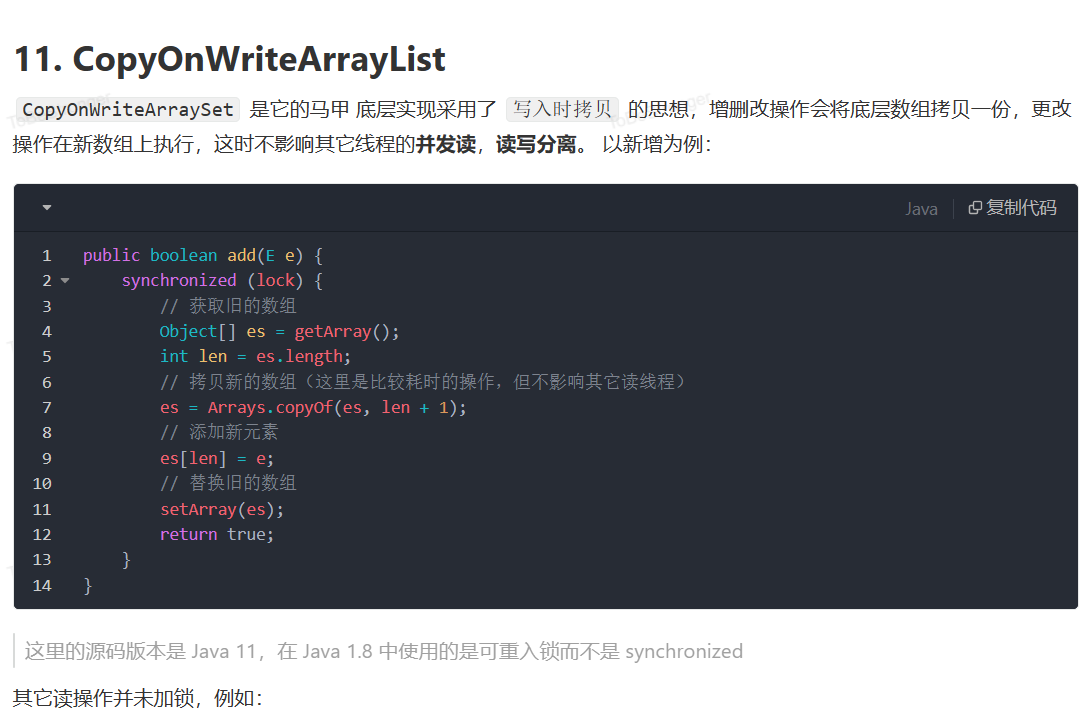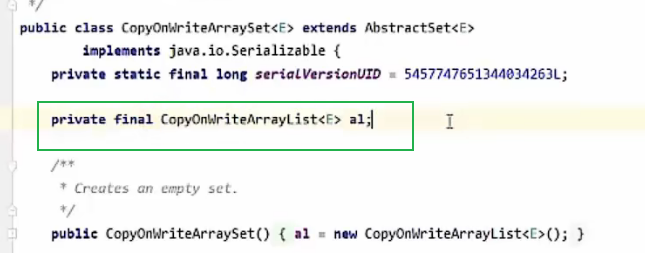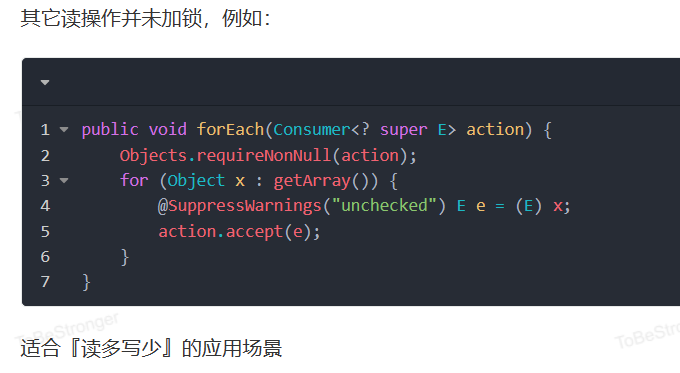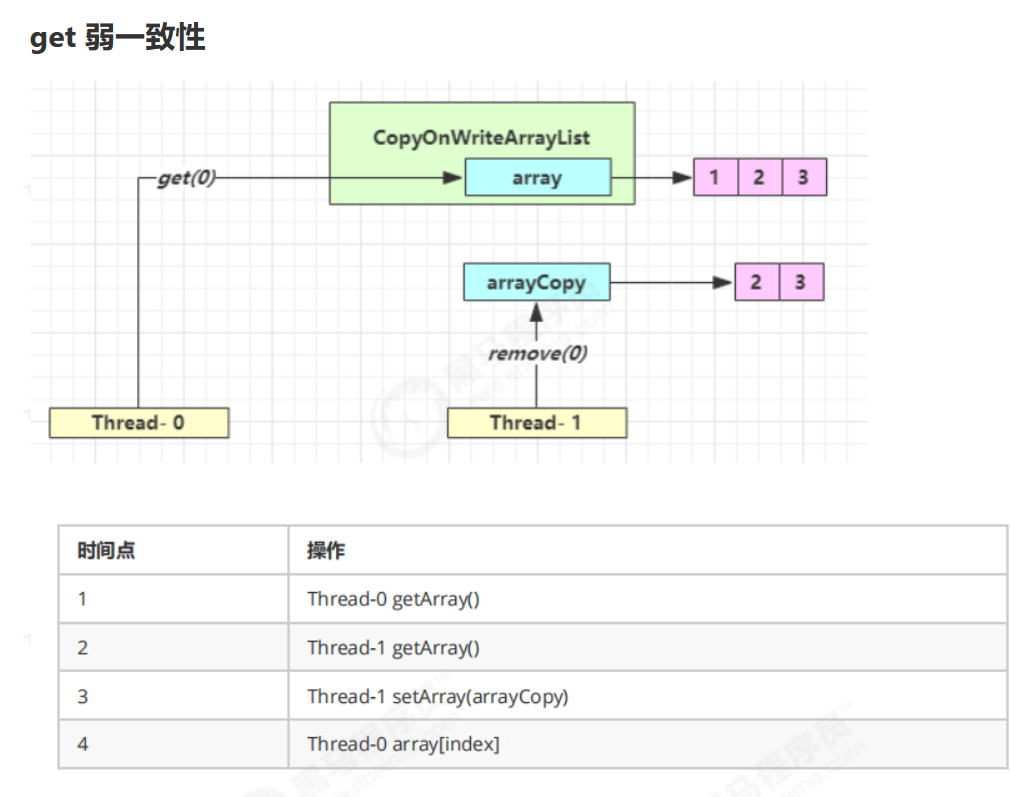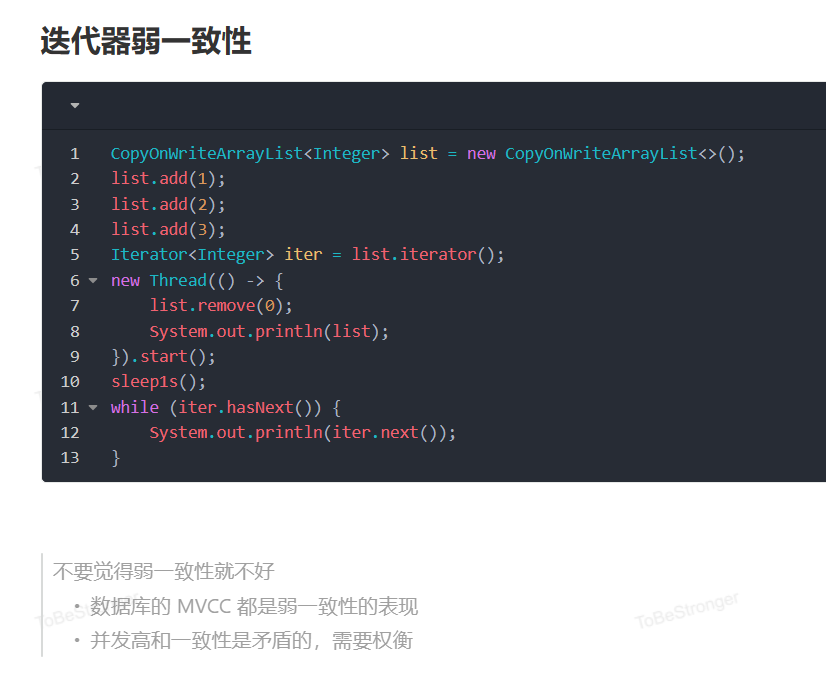第十章 ConcurrentHashMap

JUC并发编程系列文章
http://t.csdn.cn/UgzQi
文章目录
- JUC并发编程系列文章
- 前言
- 7、线程安全集合类概述
- 8、ConcurrentHashMap
-
- JDK 7 HashMap 并发死链
- JDK 8 ConcurrentHashMap
-
- 内部属性和常用方法
- 构造方法
- get 方法
- put 流程
- size 计算流程
- java 7 ConcurrentHashMap: 没人用了,不写了
- LinkedBlockingQueue 阻塞队列原理
-
- 加锁分析
- put 操作
- take 操作
- 性能比较
- ConcurrentLinkedQueue 并发队列
-
- 模仿 ConcurrentLinkedQueue
- CopyOnWriteArrayList
前言
7、线程安全集合类概述


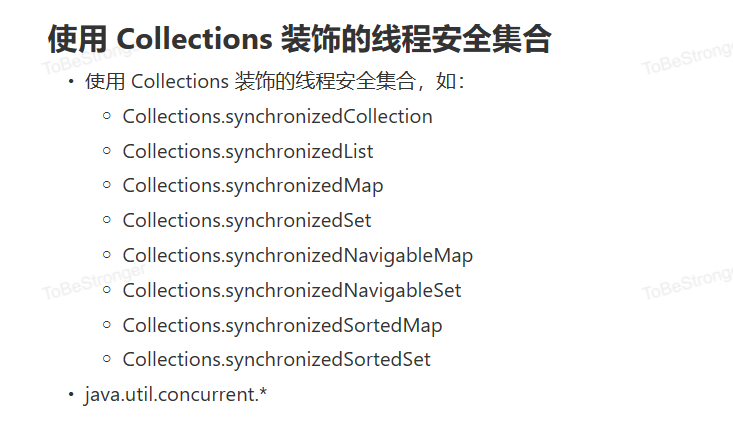
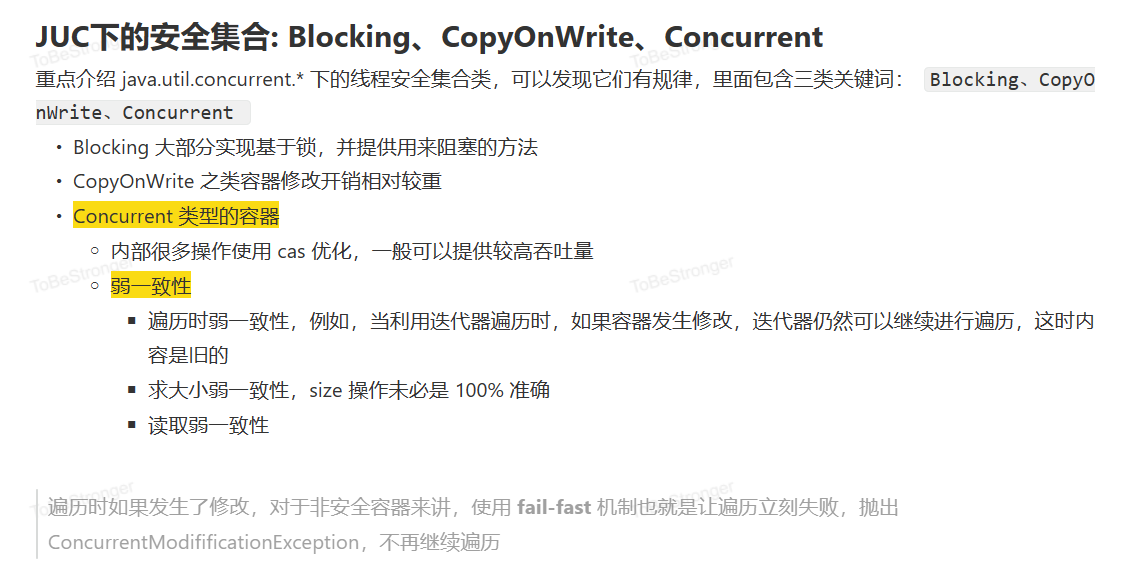
8、ConcurrentHashMap
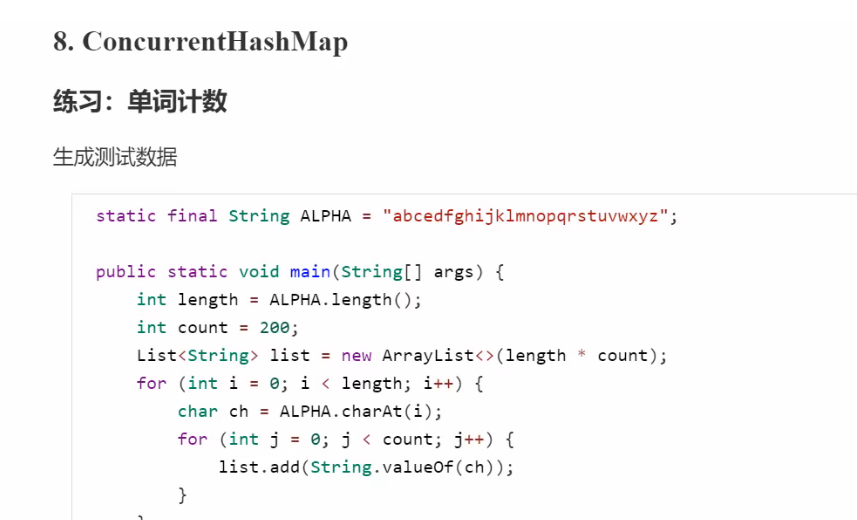
创建文件
import lombok.extern.slf4j.Slf4j;import java.io.FileOutputStream;
import java.io.IOException;
import java.io.OutputStreamWriter;
import java.io.PrintWriter;
import java.util.*;
import java.util.concurrent.*;
import java.util.concurrent.atomic.AtomicInteger;
import java.util.stream.Collectors;@Slf4j(topic = "c.testThread31")
public class testThread31 {static final String ALPHA = "abcedfghijklmnopqrstuvwxyz";public static void main(String[] args) {int length = ALPHA.length();int count = 200;List<String> list = new ArrayList<>(length * count);for (int i = 0; i < length; i++) {char ch = ALPHA.charAt(i);for (int j = 0; j < count; j++) {list.add(String.valueOf(ch));}}Collections.shuffle(list);for (int i = 0; i < 26; i++) {try (PrintWriter out = new PrintWriter(new OutputStreamWriter(new FileOutputStream("threadTest/" + (i+1) + ".txt")))) {String collect = list.subList(i * count, (i + 1) * count).stream().collect(Collectors.joining("\\n"));out.print(collect);} catch (IOException e) {}}}
}模版代码,模版代码中封装了多线程读取文件的代码
import lombok.extern.slf4j.Slf4j;import java.io.*;
import java.util.*;
import java.util.concurrent.*;
import java.util.concurrent.atomic.AtomicInteger;
import java.util.concurrent.atomic.LongAdder;
import java.util.function.BiConsumer;
import java.util.function.Supplier;
import java.util.stream.Collectors;@Slf4j(topic = "c.testThread31")
public class testThread31 {static final String ALPHA = "abcedfghijklmnopqrstuvwxyz";public static void main(String[] args) {/* {a=200, b=200, c=200, d=200, e=200, f=200, g=200, h=200, i=200, j=200, k=200, * l=200, m=200, n=200, o=200, p=200, q=200, r=200, s=200, t=200, u=200, v=200, w=200, x=200, y=200, z=200} 进程已结束,退出代码为 0*/demo(()-> new ConcurrentHashMap<String, LongAdder>(),(map,words)->{for (String word :words){LongAdder value = map.computeIfAbsent(word, (key) -> new LongAdder());//原子累加value.increment();}});// demo(
// // 创建 map 集合
// // 创建 ConcurrentHashMap 对不对?
// () -> new HashMap<String, Integer>(),
// // 进行计数
// (map, words) -> {
// for (String word : words) {
// //这里的getter和setter无法保证原子性
// //判断 key 是否已经存在
// Integer counter = map.get(word);
// //是否为空,为空计数加一,后续直接在原基础上加一
// int newValue = counter == null ? 1 : counter + 1;
// //将 map 更新
// map.put(word, newValue);
// }
// }
// );}private static <V> void demo(Supplier<Map<String,V>> supplier,BiConsumer<Map<String,V>,List<String>> consumer) {Map<String, V> counterMap = supplier.get();List<Thread> ts = new ArrayList<>();for (int i = 1; i <= 26; i++) {int idx = i;Thread thread = new Thread(() -> {List<String> words = readFromFile(idx);consumer.accept(counterMap, words);});ts.add(thread);}ts.forEach(t->t.start());ts.forEach(t-> {try {t.join();} catch (InterruptedException e) {e.printStackTrace();}});System.out.println(counterMap);}public static List<String> readFromFile(int i) {ArrayList<String> words = new ArrayList<>();try (BufferedReader in = new BufferedReader(new InputStreamReader(new FileInputStream("threadTest/"+ i +".txt")))) {while(true) {String word = in.readLine();if(word == null) {break;}words.add(word);}return words;} catch (IOException e) {throw new RuntimeException(e);}}public static void testTXT(){int length = ALPHA.length();int count = 200;List<String> list = new ArrayList<>(length * count);for (int i = 0; i < length; i++) {char ch = ALPHA.charAt(i);for (int j = 0; j < count; j++) {list.add(String.valueOf(ch));}}Collections.shuffle(list);for (int i = 0; i < 26; i++) {try (PrintWriter out = new PrintWriter(new OutputStreamWriter(new FileOutputStream("threadTest/" + (i+1) + ".txt")))) {String collect = list.subList(i * count, (i + 1) * count).stream().collect(Collectors.joining("\\n"));out.print(collect);} catch (IOException e) {}}}
}JDK 7 HashMap 并发死链
JDK 7 已经没有人用了,没必要学了

JDK 8 ConcurrentHashMap
内部属性和常用方法
内部属性
// 默认为 0
// 当初始化时, 为 -1
// 当扩容时, 为 -(1 + 扩容线程数)
// 当初始化或扩容完成后,为 下一次的扩容的阈值大小
private transient volatile int sizeCtl;// 整个 ConcurrentHashMap 就是一个 Node[]
static class Node<K,V> implements Map.Entry<K,V> {}// hash 表
transient volatile Node<K,V>[] table;// 扩容时的 新 hash 表
private transient volatile Node<K,V>[] nextTable;// 扩容时如果某个 bin 迁移完毕, 用 ForwardingNode 作为旧 table bin 的头结点
static final class ForwardingNode<K,V> extends Node<K,V> {}// 用在 compute 以及 computeIfAbsent 时, 用来占位, 计算完成后替换为普通 Node
static final class ReservationNode<K,V> extends Node<K,V> {}// 作为 treebin 的头节点, 存储 root 和 first
static final class TreeBin<K,V> extends Node<K,V> {}// 作为 treebin 的节点, 存储 parent, left, right
static final class TreeNode<K,V> extends Node<K,V> {}
常用方法
// 获取 Node[] 中第 i 个 Node
static final <K,V> Node<K,V> tabAt(Node<K,V>[] tab, int i)// cas 修改 Node[] 中第 i 个 Node 的值, c 为旧值, v 为新值
static final <K,V> boolean casTabAt(Node<K,V>[] tab, int i, Node<K,V> c, Node<K,V> v)// 直接修改 Node[] 中第 i 个 Node 的值, v 为新值
static final <K,V> void setTabAt(Node<K,V>[] tab, int i, Node<K,V> v)
构造方法
public ConcurrentHashMap(int initialCapacity,float loadFactor, int concurrencyLevel) {if (!(loadFactor > 0.0f) || initialCapacity < 0 || concurrencyLevel <= 0)throw new IllegalArgumentException();if (initialCapacity < concurrencyLevel) // Use at least as many binsinitialCapacity = concurrencyLevel; // as estimated threadslong size = (long)(1.0 + (long)initialCapacity / loadFactor);int cap = (size >= (long)MAXIMUM_CAPACITY) ?MAXIMUM_CAPACITY : tableSizeFor((int)size);this.sizeCtl = cap;}
分析: 可以看到实现了懒惰初始化,在构造方法中仅仅计算了 table 的大小,以后在第一次使用时才会真正创建,如果没有往map添加元素不会正在创建相关的内存空间,懒惰初始化
public ConcurrentHashMap(int initialCapacity, float loadFactor, int concurrencyLevel) {判断传入的数据是否合法if (!(loadFactor > 0.0f) || initialCapacity < 0 || concurrencyLevel <= 0)throw new IllegalArgumentException();判断初始容量是否大于并发度,如果小于并发度,将并发度赋值给初始容量if (initialCapacity < concurrencyLevel) // Use at least as many binsinitialCapacity = concurrencyLevel; // as estimated threads计算扩数组长度,但是需要是 2的 n 次方,所以传入的 initialCapacity,也并不会是真正的长度long size = (long)(1.0 + (long)initialCapacity / loadFactor);// tableSizeFor 仍然是保证计算的大小是 2^n, 即 16,32,64 ... int cap = (size >= (long)MAXIMUM_CAPACITY) ?MAXIMUM_CAPACITY : tableSizeFor((int)size);this.sizeCtl = cap;
}
get 方法

public V get(Object key) {Node<K,V>[] tab; Node<K,V> e, p; int n, eh; K ek;// spread 方法能确保返回结果是正数int h = spread(key.hashCode());if ((tab = table) != null && (n = tab.length) > 0 &&(e = tabAt(tab, (n - 1) & h)) != null) {// 如果头结点已经是要查找的 keyif ((eh = e.hash) == h) {if ((ek = e.key) == key || (ek != null && key.equals(ek)))return e.val;}// hash 为负数表示该 bin 在扩容中或是 treebin, 这时调用 find 方法来查找,从数组的最后往前找else if (eh < 0)return (p = e.find(h, key)) != null ? p.val : null;// 正常遍历链表, 用 equals 比较while ((e = e.next) != null) {if (e.hash == h &&((ek = e.key) == key || (ek != null && key.equals(ek))))return e.val;}}return null;
}
put 流程
以下数组简称(table),链表简称(bin)
public V put(K key, V value) {return putVal(key, value, false);
}final V putVal(K key, V value, boolean onlyIfAbsent) {if (key == null || value == null) throw new NullPointerException();// 其中 spread 方法会综合高位低位, 具有更好的 hash 性int hash = spread(key.hashCode());int binCount = 0;for (Node<K,V>[] tab = table;;) {// f 是链表头节点// fh 是链表头结点的 hash// i 是链表在 table 中的下标Node<K,V> f; int n, i, fh;// 要创建 tableif (tab == null || (n = tab.length) == 0)// 初始化 table 使用了 cas, 无需 synchronized 创建成功, 进入下一轮循环tab = initTable();// 要创建链表头节点else if ((f = tabAt(tab, i = (n - 1) & hash)) == null) {// 添加链表头使用了 cas, 无需 synchronizedif (casTabAt(tab, i, null,new Node<K,V>(hash, key, value, null)))break;}// 帮忙扩容else if ((fh = f.hash) == MOVED)// 帮忙之后, 进入下一轮循环tab = helpTransfer(tab, f);else {V oldVal = null;// 锁住链表头节点synchronized (f) {// 再次确认链表头节点没有被移动if (tabAt(tab, i) == f) {// 链表if (fh >= 0) {binCount = 1;// 遍历链表for (Node<K,V> e = f;; ++binCount) {K ek;// 找到相同的 keyif (e.hash == hash &&((ek = e.key) == key ||(ek != null && key.equals(ek)))) {oldVal = e.val;// 更新if (!onlyIfAbsent)e.val = value;break;}Node<K,V> pred = e;// 已经是最后的节点了, 新增 Node, 追加至链表尾if ((e = e.next) == null) {pred.next = new Node<K,V>(hash, key,value, null);break;}}}// 红黑树else if (f instanceof TreeBin) {Node<K,V> p;binCount = 2;// putTreeVal 会看 key 是否已经在树中, 是, 则返回对应的 TreeNodeif ((p = ((TreeBin<K,V>)f).putTreeVal(hash, key,value)) != null) {oldVal = p.val;if (!onlyIfAbsent)p.val = value;}}}// 释放链表头节点的锁}if (binCount != 0) { if (binCount >= TREEIFY_THRESHOLD)// 如果链表长度 >= 树化阈值(8), 进行链表转为红黑树treeifyBin(tab, i);if (oldVal != null)return oldVal;break;}}}// 增加 size 计数addCount(1L, binCount);return null;
}private final Node<K,V>[] initTable() {Node<K,V>[] tab; int sc;while ((tab = table) == null || tab.length == 0) {if ((sc = sizeCtl) < 0)Thread.yield();// 尝试将 sizeCtl 设置为 -1(表示初始化 table)else if (U.compareAndSwapInt(this, SIZECTL, sc, -1)) {// 获得锁, 创建 table, 这时其它线程会在 while() 循环中 yield 直至 table 创建try {if ((tab = table) == null || tab.length == 0) {int n = (sc > 0) ? sc : DEFAULT_CAPACITY;Node<K,V>[] nt = (Node<K,V>[])new Node<?,?>[n];table = tab = nt;sc = n - (n >>> 2);}} finally {sizeCtl = sc;}break;}}return tab;
}// check 是之前 binCount 的个数
private final void addCount(long x, int check) {CounterCell[] as; long b, s;if (// 已经有了 counterCells, 向 cell 累加(as = counterCells) != null ||// 还没有, 向 baseCount 累加!U.compareAndSwapLong(this, BASECOUNT, b = baseCount, s = b + x)) {CounterCell a; long v; int m;boolean uncontended = true;if (// 还没有 counterCellsas == null || (m = as.length - 1) < 0 ||// 还没有 cell(a = as[ThreadLocalRandom.getProbe() & m]) == null ||// cell cas 增加计数失败!(uncontended = U.compareAndSwapLong(a, CELLVALUE, v = a.value, v + x))) {// 创建累加单元数组和cell, 累加重试fullAddCount(x, uncontended);return;}if (check <= 1)return;// 获取元素个数s = sumCount();}if (check >= 0) {Node<K,V>[] tab, nt; int n, sc;while (s >= (long)(sc = sizeCtl) && (tab = table) != null &&(n = tab.length) < MAXIMUM_CAPACITY) {int rs = resizeStamp(n);if (sc < 0) {if ((sc >>> RESIZE_STAMP_SHIFT) != rs || sc == rs + 1 ||sc == rs + MAX_RESIZERS || (nt = nextTable) == null ||transferIndex <= 0)break;// newtable 已经创建了,帮忙扩容if (U.compareAndSwapInt(this, SIZECTL, sc, sc + 1))transfer(tab, nt);}// 需要扩容,这时 newtable 未创建else if (U.compareAndSwapInt(this, SIZECTL, sc,(rs << RESIZE_STAMP_SHIFT) + 2))transfer(tab, null);s = sumCount();}}
}size 计算流程

public int size() {long n = sumCount();return ((n < 0L) ? 0 :(n > (long)Integer.MAX_VALUE) ? Integer.MAX_VALUE :(int)n);
}final long sumCount() {CounterCell[] as = counterCells; CounterCell a;// 将 baseCount 计数与所有 cell 计数累加long sum = baseCount;if (as != null) {for (int i = 0; i < as.length; ++i) {if ((a = as[i]) != null)sum += a.value;}}return sum;
}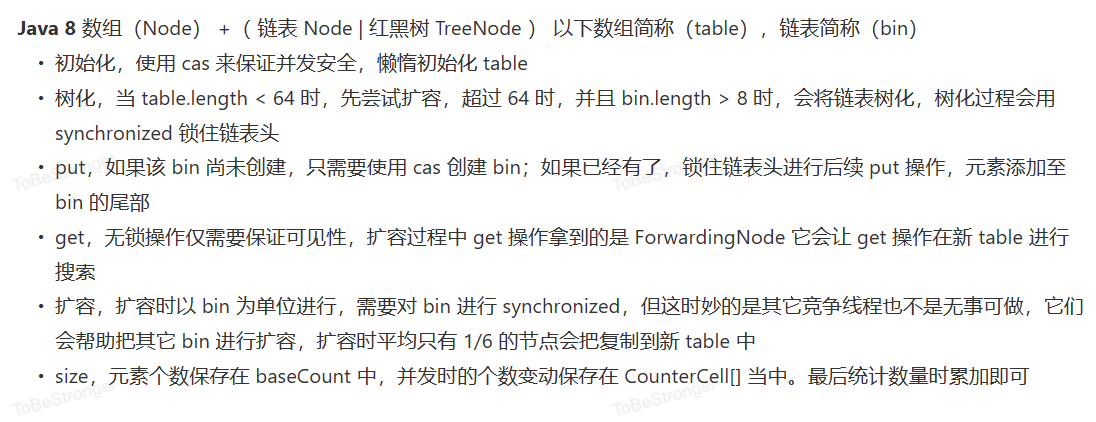
源码分析 http://www.importnew.com/28263.html
其它实现 Cliffff Click’s high scale lib
java 7 ConcurrentHashMap: 没人用了,不写了
LinkedBlockingQueue 阻塞队列原理
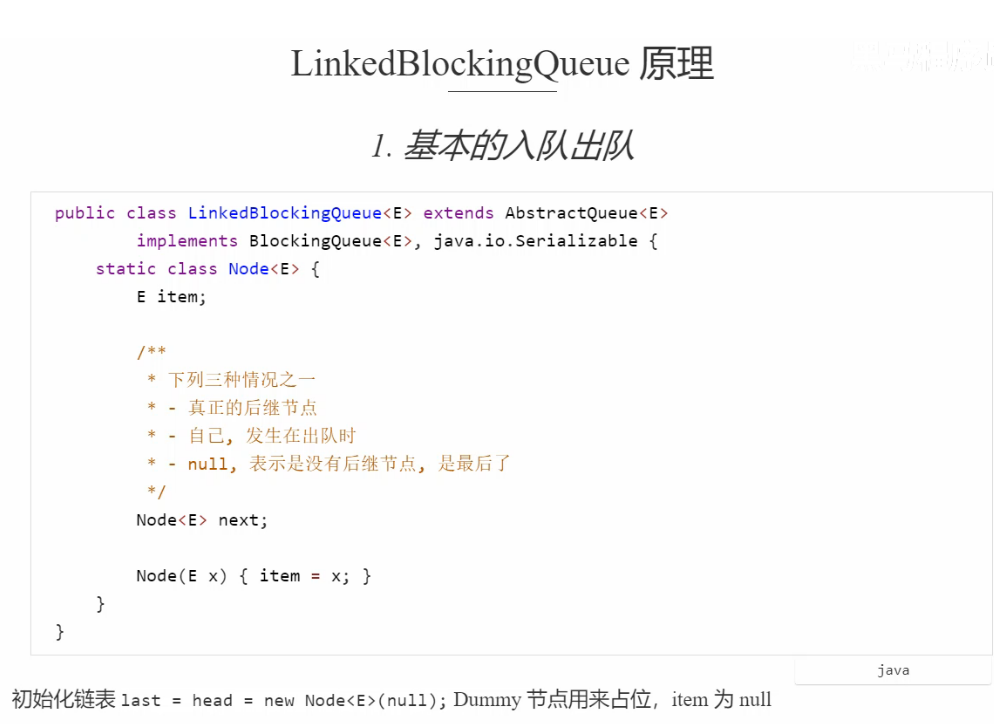



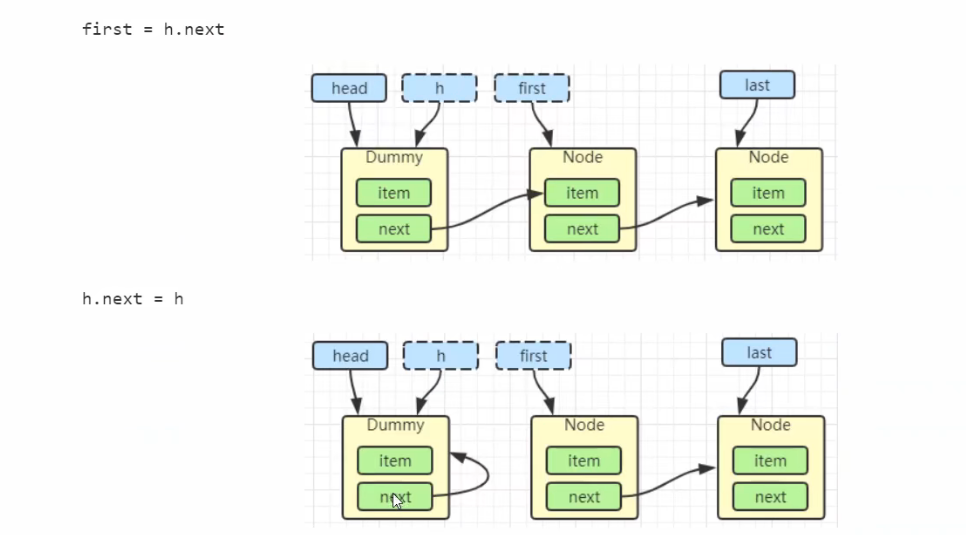

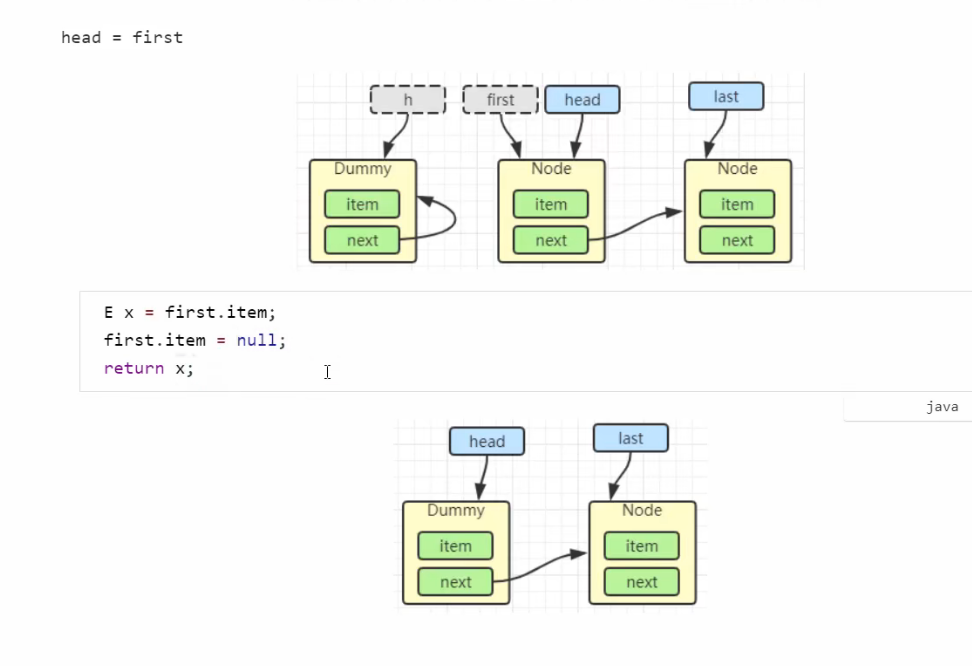
加锁分析

put 操作
public void put(E e) throws InterruptedException {if (e == null) throw new NullPointerException();int c = -1;Node<E> node = new Node<E>(e);final ReentrantLock putLock = this.putLock;// count 用来维护元素计数final AtomicInteger count = this.count;putLock.lockInterruptibly();try {// 满了等待while (count.get() == capacity) {// 倒过来读就好: 等待 notFullnotFull.await();}// 有空位, 入队且计数加一enqueue(node);c = count.getAndIncrement(); // 除了自己 put 以外, 队列还有空位, 由自己叫醒其他 put 线程if (c + 1 < capacity)notFull.signal();} finally {putLock.unlock();}// 如果队列中有一个元素, 叫醒 take 线程if (c == 0)// 这里调用的是 notEmpty.signal() 而不是 notEmpty.signalAll() 是为了减少竞争signalNotEmpty();
}take 操作
public E take() throws InterruptedException {E x;int c = -1;final AtomicInteger count = this.count;final ReentrantLock takeLock = this.takeLock;takeLock.lockInterruptibly();try {while (count.get() == 0) {notEmpty.await();}x = dequeue();c = count.getAndDecrement();if (c > 1)notEmpty.signal();} finally {takeLock.unlock();}// 如果队列中只有一个空位时, 叫醒 put 线程// 如果有多个线程进行出队, 第一个线程满足 c == capacity, 但后续线程 c < capacityif (c == capacity)// 这里调用的是 notFull.signal() 而不是 notFull.signalAll() 是为了减少竞争signalNotFull()return x;
}由 put 唤醒 put 是为了避免信号不足
性能比较

ConcurrentLinkedQueue 并发队列
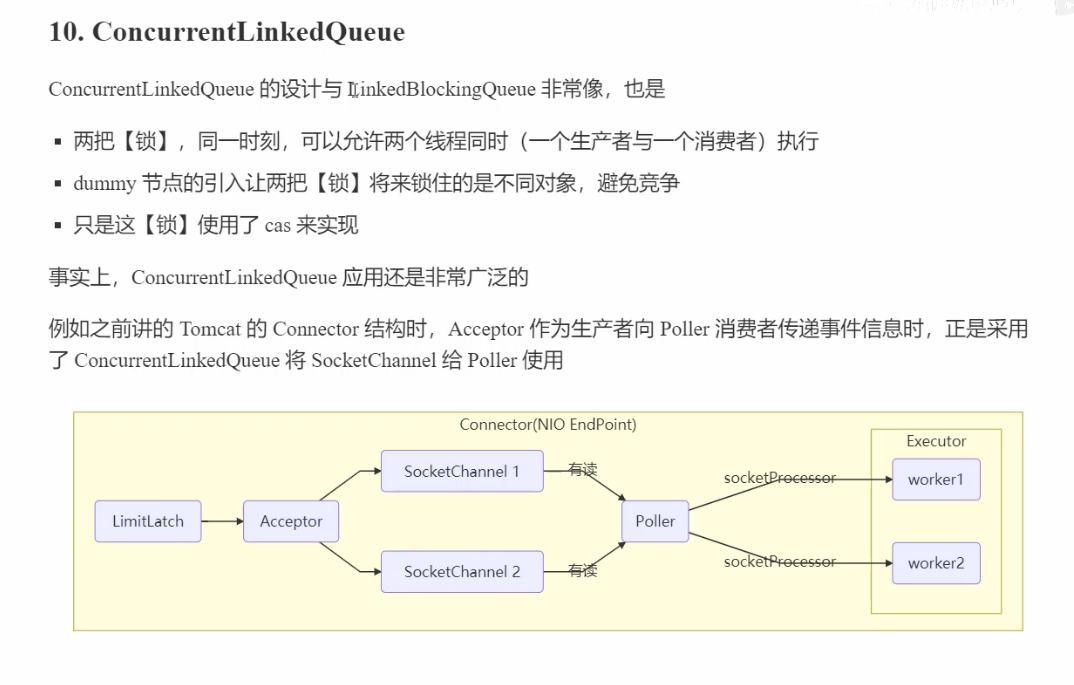
模仿 ConcurrentLinkedQueue
初始代码
package cn.itcast.concurrent.thirdpart.test;
import java.util.Collection;
import java.util.Iterator;
import java.util.Queue;
import java.util.concurrent.atomic.AtomicReference;
public class Test3 {public static void main(String[] args) {MyQueue<String> queue = new MyQueue<>();queue.offer("1");queue.offer("2");queue.offer("3");System.out.println(queue);}
}
class MyQueue<E> implements Queue<E> {@Overridepublic String toString() {StringBuilder sb = new StringBuilder();for (Node<E> p = head; p != null; p = p.next.get()) {E item = p.item;if (item != null) {sb.append(item).append("->");}}sb.append("null");return sb.toString();}@Overridepublic int size() {return 0;}@Overridepublic boolean isEmpty() {return false;}@Overridepublic boolean contains(Object o) {return false;}@Overridepublic Iterator<E> iterator() {return null;}@Overridepublic Object[] toArray() {return new Object[0];}@Overridepublic <T> T[] toArray(T[] a) {return null;}@Overridepublic boolean add(E e) {return false;}@Overridepublic boolean remove(Object o) {return false;}@Overridepublic boolean containsAll(Collection<?> c) {return false;}@Overridepublic boolean addAll(Collection<? extends E> c) {return false;}@Overridepublic boolean removeAll(Collection<?> c) {return false;}@Overridepublic boolean retainAll(Collection<?> c) {return false;}@Overridepublic void clear() {}@Overridepublic E remove() {return null;}@Overridepublic E element() {return null;}@Overridepublic E peek() {return null;}public MyQueue() {head = last = new Node<>(null, null);}private volatile Node<E> last;private volatile Node<E> head;private E dequeue() {/*Node<E> h = head;Node<E> first = h.next;h.next = h;head = first;E x = first.item;first.item = null;return x;*/return null;}@Overridepublic E poll() {return null;}@Overridepublic boolean offer(E e) {return true;}static class Node<E> {volatile E item;public Node(E item, Node<E> next) {this.item = item;this.next = new AtomicReference<>(next);}AtomicReference<Node<E>> next;}
}
offer方法
public boolean offer(E e) {Node<E> n = new Node<>(e, null);while(true) {// 获取尾节点AtomicReference<Node<E>> next = last.next;// S1: 真正尾节点的 next 是 null, cas 从 null 到新节点if(next.compareAndSet(null, n)) {// 这时的 last 已经是倒数第二, next 不为空了, 其它线程的 cas 肯定失败// S2: 更新 last 为倒数第一的节点last = n;return true;}}
}
CopyOnWriteArrayList
